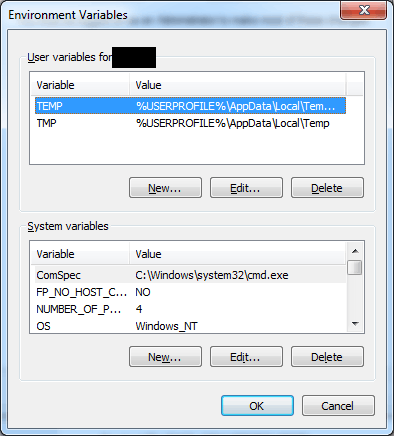22
5
Is it right to have these two environment variables TEMP and TMP? If I make changes to one should I make the same changes to the other? For example I was installing cygwin and the directions told me to change the PATH variable, but both TEMP and TMP have the path variable. What is the difference between the two?

Not sure why people want to see this but here's the values to the path: Path in TEMP: C:\Program Files\Common Files\Microsoft Shared\Windows Live;C:\Program Files (x86)\Common Files\Microsoft Shared\Windows Live;C:\Program Files (x86)\NVIDIA Corporation\PhysX\Common;%SystemRoot%\system32;%SystemRoot%;%SystemRoot%\System32\Wbem;%SYSTEMROOT%\System32\WindowsPowerShell\v1.0\;C:\Program Files (x86)\Common Files\Acronis\SnapAPI\;C:\Program Files (x86)\Windows Kits\8.1\Windows Performance Toolkit\;C:\Program Files\Microsoft SQL Server\110\Tools\Binn\;C:\Program Files (x86)\Windows Live\Shared
Path in TMP: %USERPROFILE%\AppData\Local\Temp
4
Check out the this article Why are there both TMP and TEMP environment variables, and which one is right? According to this,
– aschipfl – 2016-09-08T14:32:46.697TMPmight be the one to prefer (due to theGetTempFileNamefunction)...Where is the Path variable in the temps I can't see it in your screen shot – user151019 – 2014-02-02T12:41:07.093
@Mark what does it matter? – Celeritas – 2014-02-02T20:19:37.343
@DavidMarshall what does it matter? – Celeritas – 2014-02-03T01:23:49.533
My question isn't how to change the path variable. And if it was your guys answers would be wrong because my point is, when changing any variable should it be done to TEMP, TMP or both. And you don't specify. – Celeritas – 2014-02-03T01:24:26.537
@DavidMarshall I meant it as an example to when a distinction may need to be made. They do to both have PATH. – Celeritas – 2014-02-03T21:49:26.670
@DavidMarshall I updated the question, did I understand what you wanted to see correctly? – Celeritas – 2014-02-03T21:52:54.230
@Mark CC above comment – Celeritas – 2014-02-03T21:53:10.887
@Celeritas why do we need the PATH variable which you mention in your question and it is not part of the value of TMP. The question is not what is PATH but why do you mention it at all – user151019 – 2014-02-04T00:16:14.693
@Celeritas we don't say specify as programs will use one or the other or use them for different reasons so it depends on which programs you use – user151019 – 2014-02-04T00:17:49.890